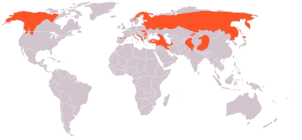Brown bearsBrown bears are large carnivores and can stretch up to 2,5 metres tall when standing upright. Males usually weigh more than 300 kg, while females average just over 200 kg. Despite their size, brown bears are extremely alert and fast runners. They have human hearing level, an excellent sense of smell, but relatively poor eyesight. Their fur colour ranges from a dark cream, to almost black in some individuals and they have long, sharp claws, which are about the same length as a human finger.
|
Living area brown bears Ursus arctos range map |
More about:
The north pole is disappearing because of air pollution. Therefor, the habitat of the polar bears is alsow decreasing.
Panda's are threatened by habitat loss. Nevertheless the population is on the rise.
|
Kinds of brown bearsApart from the earlier noticed Grizzly bear, there are four more species of brown bears. These are the Syrian bear, the Kodiak bear, the Himalayan brown bear and the Bergman's bear. The Bergman's bear, who lived in Kanchatka Peninsula, is already extinct. The Grizzly and Himalayan brown bears, have both the conservation status endangered. Grizzly bears live in the uplands of western North America, while the Himalayan brown bears live in the foothills of the Himalaya and in the north of Pakistan. Less threatened brown bears are the Syrian bear and the kodiak bear. Nevertheless, these bears have the status vulnerable. The Syrian bear lives in a large area in western Asia, but their habitat is destructed. Because of this, the population of Syrian brown bears is declining. Kodiak bears are unique, because they have been isolated from other bears for 12,000 years. They live solely on the islands in the Kodiak Archipelago. |
News about brown bears |

 Brown bears face the threat of hunting for many years.
Between 1800 and 1975,
Brown bears face the threat of hunting for many years.
Between 1800 and 1975, 